Q&A – Ask Neil: January 2, 2025
(Please read these instructions carefully.)
Before you post your question, please look at recent issues to see if someone else has already asked it. You might find your answer there.
How to submit your question…
(Note: You may need to allow a pop-up window to come up in order to get the link for sending your photo(s). If you have already submitted your question and didn’t see the pop-up window, please click here.)
• Click the link provided below to post your question. After you submit your question, a new window will pop up giving you the address to which you can e-mail a SHARP, HIGH-RESOLUTION PHOTO to accompany your question. Please DO NOT SEND THUMBNAIL PHOTOS in case I need to zoom in to see things.
• Click here to post your question.
• Please ONLY POST YOUR QUESTION ONE TIME. We can only accept a set number of questions each week, and when we get duplicates it costs other people their chances.
• One question per reader, please.
• Please use this only for posting questions – not for standard emails.
• Watch for your answer in the following week’s e-gardens.
• I choose those of greatest general interest. For example, plant IDs seldom make the cut.
• I must have your first name or initials.
• I must have your city or county. (Texas is a very large state.)
QUESTION 1
ANY TIPS ON GETTING PINEAPPLES THROUGH THE WINTER?
Question: I’m following your suggestions on growing pineapples from the tops of the fruit, and I wondered if you have any tips on getting them through the winter? Brandon S., Tyler.
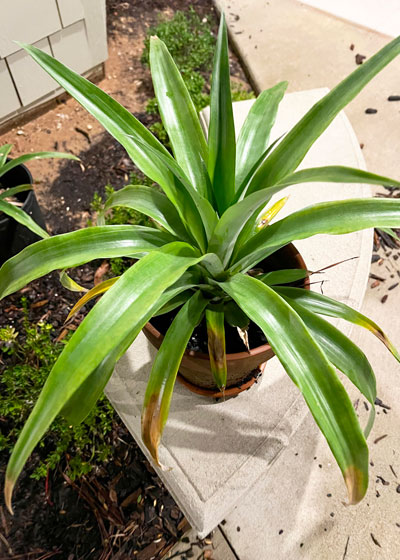
Answer: Pineapples are tropical bromeliads, just like the many colorful types that you see in flower shops and nurseries. As such, they must be protected from temperatures anywhere near freezing. That means they need to be kept in a greenhouse or very bright room/sunroom indoors at “people” temperatures. It looks like you’re doing a great job so far.
To everyone else, his next step as it grows larger next spring and especially by late summer will be to put an apple core into the center of the plant, then cover it air-tight with dry-cleaner’s plastic. Use a rubber band to seal the gasses of the decaying apple within the bag of air for 4-5 weeks. The ethylene gas the core gives off will trigger the flowering process in the pineapple. He knows not to put the covered plant in the sun because it would overheat. Within 6 to 8 weeks, he should begin to see a change in the structure of the leaves in the center as the small fruit starts to develop. At that point he can open the bag, discard the plastic and old apple core, and let the pineapple proceed with forming its fruit. It may need to have a lightweight stake to hold it upright.
QUESTION 2
WHY IS ONE OF OUR NELLIE R. STEVENS HOLLIES DYING?
Question: One of our five Nellie R. Stevens hollies looks like it is dying. Its leaves are pale green, and they look like they are being eaten. The four others nearby are all fine. What is going wrong? Ronald A., Poolville.
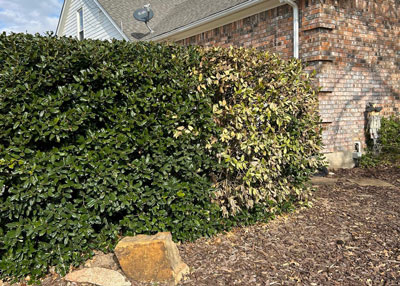
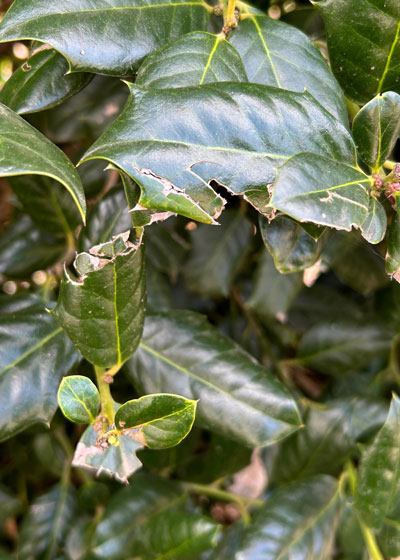
Answer: The only thing I have ever seen cause this kind of symptom is letting a holly get too dry. Sadly, I’ve seen it hundreds of times. My guess would be that it happened back in September and October when we had the extended period of hot, dry weather. I do note how healthy your other plants look. If you have a sprinkler system, it’s possible that the head that serves that end of the bed isn’t functioning properly. It’s also possible that there has been some type of injury to the trunk near the ground line. That could have been from some exotic problem such as a line trimmer way up under the plants or even a woodpecker riddling the trunk. I’ve seen that on my own hollies two or three times over the past 47 years. But by far the majority of times it’s been due to simply letting plants get too dry. Hollies don’t wilt, so the problems are subtle and damage happens before we know it. That’s the best I can do from what I can see.
Oh, and relative to something eating the leaves – your photo shows the aftermath of trimmer cuts from your hedge trimmer. Bite marks from a grasshopper, for example, would be much more jagged. This browning is not due to insects.
QUESTION 3
I’VE LOST MY LAST TWO ST. AUGUSTINE LAWNS TO TARR. HOW DO I PROCEED?
Question: I don’t know how to proceed. I have lost my last two St. Augustine lawns due to Take All Root Rot after spending many, many dollars trying to save them. What should I do? All I have left is dirt and remnants. I did try some hybrid bermuda, and it is holding on in some places. Help! David S., Tarrant County.
Answer: Take All Root Rot is an insidious disease that has only been identified (to my knowledge) for the past 30 or 35 years. In that time, it has become one of the leading causes of problems with St. Augustine in much of Texas. It shows up in the cool weather of mid-spring, generally attacking St. Augustine that has been weakened by poor drainage or cultural problems. To deal with TARR you must also solve those other issues.
One of the main weakening agents for St. Augustine is shade. In my own personal situation, I found that as the trees grew larger our St. Augustine struggled more and more just from the competition for light. As it weakened, TARR became more and more difficult to control.
Therefore, my first suggestion will be to check the amount of sunlight your lawn is receiving during the growing season. Whether TARR is involved or not, St. Augustine must have 6 or 7 hours of direct sunlight to thrive in North Texas where you are. Folks in South Texas can get by with 5 or 6 hours because winter doesn’t take such a toll on their lawns.
If you don’t get that much sunlight, you need either to try removing a lower branch or two to allow more light to the lawn, or you could switch to a shade-proof groundcover such as regular mondograss, liriope, or English ivy.
If you do get full sunlight and you still want to try St. Augustine, apply Azoxystrobin to the lawn to stop the spread of the TARR fungus. Many years ago our recommendation was to spread a 1-in. layer of sphagnum peat across the entire lawn, but that merely suppressed the development of the fungus. The Azoxystrobin will actually kill the disease. You might try a small area before you make another big expenditure.
QUESTION 4
HOW CAN WE PRUNE A NEWLY TRANSPLANTED CRAPE MYRTLE THAT IS ALREADY TOO TALL?
Question: We transplanted a crape myrtle from a spot that required it to grow taller (to 20 ft.) to reach sunlight. Now it’s in full sunlight, but it doesn’t start branching until about 12 ft. high. How would you suggest cutting it back? David L., Southlake.
Answer: The key thing to remember is that you must never leave stubs. Anytime you reduce the height of a branch by cutting one back, make the cut flush with a remaining branch so that you don’t get a bevy of sprouts emerging around the stem.
The first growing season your main goal is to keep it alive and vigorous so it can expend most of its energy in producing new roots. Top growth will follow in successive years. Thin out trunks and branches that you know will never take part in developing the final form of the tree. I always suggest making a cut, then stepping back 15 or 20 feet to decide which branch needs to be removed next. It requires patience and thinking ahead as to how the plant will grow and fill in.
Remember, too, that crape myrtles usually send up a few new shoots from the ground. It’s just fine to leave a couple of those in place if you need additional trunks. They will grow quickly and turn woody within a couple of years. They’ll soon become a part of the “team.”
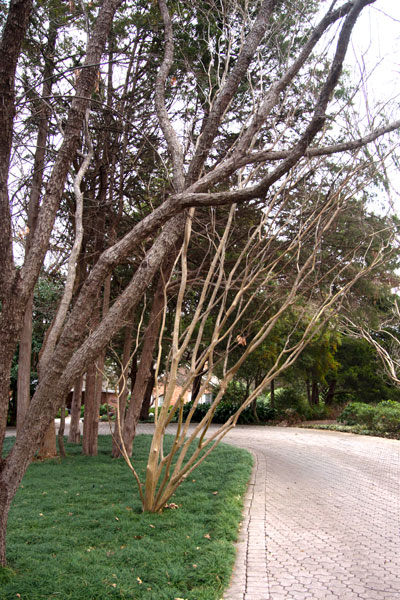
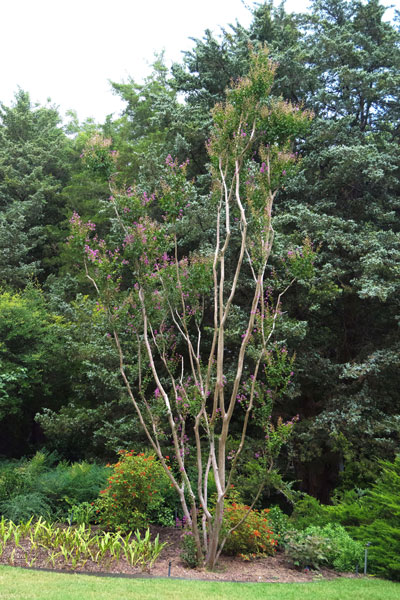
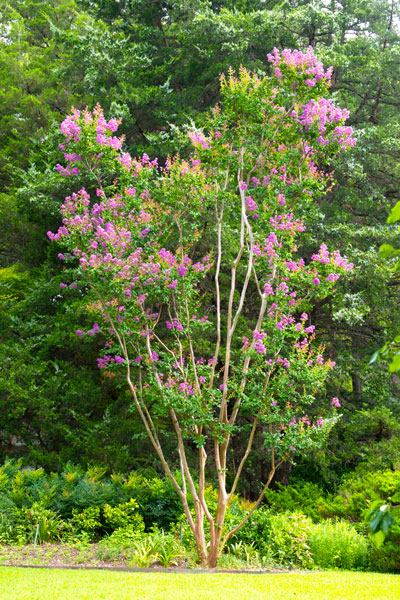
Your question is almost as if I drew it up myself. You didn’t include any photos, so I’m going to show three photos of a 20-ft. Catawba crape myrtle that became overrun by our native redcedars and pecans. We dug it 10 years ago and moved it as you did yours – to a location in full sun. I trimmed it to remove about 40 percent of its top growth, mostly by thinning out stems. You’ll notice that it did bloom even the first year, but by the third summer it was growing and doing quite well. It now looks like it’s been growing there almost since Day 1, and within another couple of years it should be fully broadened out.
QUESTION 5
WHY IS “SOAPSUDS” FLOWING FROM THE SOUTH SIDE OF MY BUR OAK’S TRUNK? IS THIS A CONCERN?
Question: Why is “soapsuds” flowing from the south side of my burr oak’s trunk? Is this something of concern? Should I contact someone to have it treated? Nixie R., Ellis County.
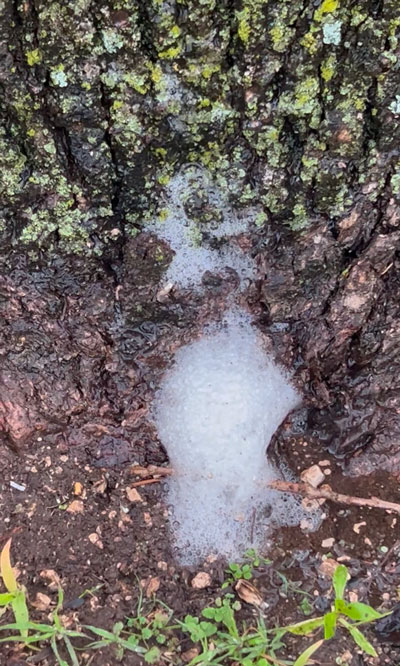
Answer: There is decay within the wood of the trunk of this tree, and the pressure that has built up within the conducting tissues is sending the sap out under pressure, much as foaming hand soap comes out of the bottle when we push down on the pump.
This is definitely a cause for concern. I would have a certified arborist look closely at the tree. You want someone with those credentials from the International Society of Arboriculture. That organization’s website has a “Find a certified arborist” button on its website.
